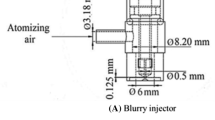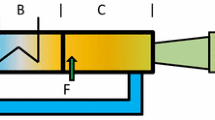Abstract
This study deals with the impact of the operating conditions, e.g. pressure, preheating temperature, pressure drop across the nozzle, nozzle size and stoichiometry, on the reaction zone location and spray evaporation progress in case of a lifted flame. Lifted flames are highly valued for their NOx reduction potential and for their low susceptibility to flash-back and thermo-acoustic instabilities. These advantageous features arise from the improved homogeneity of the fuel-air mixture provided to the reaction zone. One distinctive feature of the lifted flames is the presence of the so called lift-off zone located between nozzle outlet and main reaction zone. Within the lift-off zone fuel and oxidizer remain a certain time in contact and mix together prior to the onset of the combustion reaction. This leads to a more uniform heat release distribution and lowers the nitrogen oxides emissions at lean conditions by reducing the temperature spikes. In contrast to many other studies the subject of investigation was not a plain jet flame, but a modified version of the airblast nozzle, widely used in industrial applications. The nozzle was operated with liquid kerosene. As liquid fuels are easier to handle than gaseous or solid, it is expected that many efforts in the future will focus on the development of liquid fuels surrogates. Our previous investigations have shown, that the nozzle is well suited to be operated with gaseous fuels as well (Fokaides et al, J Eng Gas Turbine Power 130, 011508 2008). The position of the reaction zone was determined by means of chemiluminescence of the OH∗ radicals and from its location the lift-off height was derived. In addition the fuel evaporation progress was measured by means of light scattering, revealing that fuel droplets and main reaction zone are well separated. It was found that the operating conditions have a versatile impact on the length of the lift-off zone and spray cone and thus on the degree of pre-evaporation and premixing. Thus, it may be concluded, that through a proper choice of operating conditions and combustor size a desired lift-off height can be adjusted in accordance with criteria, like available space, required emission levels etc.
Similar content being viewed by others
References
Fokaides, P., Kasabov, P., Zarzalis, N.: Experimental investigation of the stability mechanism and emissions of a lifted swirl non-premixed flame. J. Eng. Gas Turbine Power 130, 01158 (2008)
Linan, A., Williams, F.: Fundamental Aspects of Combustion. Oxford Univ Press, Oxford (1995)
Fric, T.: Effects of fuel-air unmixedness on NOx emissions. J. Propuls. Power 9(5), 708–713 (1993)
Leonard, G., Stegmaier, J.: Development of an aeroderivative gas turbine dry low emissions combustion system. ASME J. Eng. Gas Turbines Power 116, 542–546 (1994)
Wohl, K., Kapp, N., Gazley, C.: The stability of open flames. In: Third Symposium on Combustion, Flame and Explosion Phenomena, 3–21 (1949)
Vanquickenborne, L., Van Tiggelen, A.: The stabilization mechanism of lifted diffusion flames. Combust. Flame 10, 59–69 (1966)
Eickhoff, H., Lenze, B., Leuckel, W.: Experimental investigation on the stabilization mechanism of jet diffusion flames. In: Twentieth Symposium (International) on Combustion, 311–318 (1984)
Peters, N., Williams, F.: Lift-off characteristics of turbulent jet diffusion flames. AIAA J. 21(3), 423–429 (1983)
Peters, N.: Turbulent Combustion. Cambridge University Press, Cambridge, UK (1999)
Schefer, R., Namazian, M., Filtopoulos, E., Kelly, J.: Temporal evolution of turbulence/chemistry interactions in lifted, turbulent-jet flames. In: Twenty-Fifth Symposium (International) on Combustion 1223–1231 (1994)
Kalghatgi, G.: Blow-out stability of gaseous jet diffusion flames. Part I: in still air. Combust. Sci. Technol. 41, 17–29 (1984)
Donnerhack, S., Peters, N.: Stabilization heights in lifted methane-air jet diffusion flames diluted with nitrogen. Combust. Sci. Technol. 41, 101–108 (1984)
Miake-Lye, R., Hammer, J.: Lifted turbulent jet flames: a stability criterion based on the jet large-scale structure. In: Twenty-Second Symposium (International) on Combustion, 817–824 (1988)
Zarzalis, N., Fokaides, P., Merkle, K.: Fuel injection apparatus. Patent No. DE 10 2005 022 772.4, EP 06 009 563.5 (2005)
Thring, M., Newby, M.: Combustion length of enclosed turbulent jet flames. In: Fourth Symposium (International) on Combustion, 789–796 (1953)
Kasabov, P., Zarzalis, N.: Pressure dependence of the stability limits and the NOx exhaust gas concentrations in case of swirl-stabilized, diffusion flames burning in a lift-off regime. In: Proceedings of ASME Turbo Expo 2009: Power for Land, Sea and Air. ASME, Orlando, USA (2009)
Lauer, M., Sattelmayer, T.: On the adequacy of chemiluminescence as a measure for heat release in turbulent flames with mixture gradients. In: Proceedings of ASME Turbo Expo 2009: Power for Land, Sea and Air. ASME, Orlando, USA (2009)
Giuliani, F., Berthoumieu, P., Becker, J., Hassa, C.: The effect of ambient air pressure on planar liquid sheet disintegration at gas turbine conditions. In: Proceedings of the 19th ILASS Europe Conference. Nottingham, UK (2004)
Damköhler, G.: The effect of turbulence on the flame velocity in gas mixtures. Zeitschrift Electrochem. 46, 601–626 (1940)
Klimov, A.: Premixed turbulent flames—interplay of hydrodynamic and chemical phenomena. Flames, Lasers and Reactive Systems, AIAA Progress in Astronautics and Aeronautics 88, 133–146 (1983)
Pieringer, J., Brandt, M., Polifke, W., Griebel, P., Siewert, P., Bombach, R., Inauen, A., Kreutner, W.: Anwendung von Modellen der turbulenten Flammengeschwindigkeit auf einen vorgemischten Strahlbrenner. VDI-Ber. 1750, 629–634 (2003)
Zimont, V., Mesheriakov, E.: A model of combustion of partially premixed gases. Structure of gas flames. In: Proceedings of International Colloquium, Novosibirsk (1988)
Schmid, H.-P.: Ein Verbrennungsmodell zur Beschreibung der Wärmefreisetztung von vorgemischten Turbulenten Flammen. Ph.D. Thesis, University of Karlsruhe, Karlsruhe (1995)
Bradley, D., Lawes, M., Sheppard, C.: Study of turbulence and combustion interaction: measurement and prediction of the rate of turbulent burning. University of Leeds, Leeds (1994)
Bradley, D., Hicks, R., Lawes, M., Sheppard, C., Woolley, R.: The measurement of laminar burning velocities and markstein numbers for iso-octane-air and iso-octane-n-heptane-air mixtures at elevated temperatures and pressures in an explosion bomb. Combust. Flame 115, 126–144 (1998)
Author information
Authors and Affiliations
Corresponding author
Rights and permissions
About this article
Cite this article
Kasabov, P., Zarzalis, N. & Habisreuther, P. Experimental Study on Lifted Flames Operated with Liquid Kerosene at Elevated Pressure and Stabilized by Outer Recirculation. Flow Turbulence Combust 90, 605–619 (2013). https://doi.org/10.1007/s10494-013-9444-1
Received:
Accepted:
Published:
Issue Date:
DOI: https://doi.org/10.1007/s10494-013-9444-1




